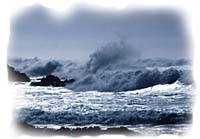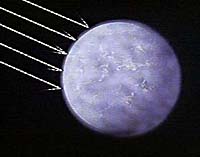Noah’s Flood—Where did the water come from?

In telling us about the world-changing Flood in the days of Noah, the Bible gives us much information about where the waters came from and where they went. The sources of the water are given in Genesis 7:11 as “the fountains of the great deep” and the “windows of heaven.”
The Fountains of the Great Deep
The “fountains of the great deep” are mentioned before the “windows of heaven,” indicating either relative importance or the order of events.
What are the “fountains of the great deep?” This phrase is used only in Genesis 7:11. “Fountains of the deep” is used in Genesis 8:2, where it clearly refers to the same thing, and Proverbs 8:28, where the precise meaning is not clear. “The great deep” is used three other times: Isaiah 51:10, where it clearly refers to the ocean; Amos 7:4, where God’s fire of judgment is said to dry up the great deep, probably the oceans; and Psalm 36:6 where it is used metaphorically of the depth of God’s justice/judgment. “The deep” is used more often, and usually refers to the oceans (e.g., Genesis 1:2; Job 38:30, 41:32; Psalm 42:7, 104:6; Isaiah 51:10, 63:13; Ezekiel 26:19; Jonah 2:3), but sometimes to subterranean sources of water (Ezekiel 31:4, 15). The Hebrew word (mayan) translated “fountains” means “fountain, spring, well.”[1]
So, the “fountains of the great deep” are probably oceanic or possibly subterranean sources of water. In the context of the flood account, it could mean both.

If the fountains of the great deep were the major source of the waters, then they must have been a huge source of water. Some have suggested that when God made the dry land appear from under the waters on the third day of creation, some of the water that covered the earth became trapped underneath and within the dry land.[2]
Genesis 7:11 says that on the day the flood began, there was a “breaking up” of the fountains, which implies a release of the water, possibly through large fissures in the ground or in the sea floor. The waters that had been held back burst forth with catastrophic consequences.
There are many volcanic rocks interspersed between the fossil layers in the rock record—layers that were obviously deposited during Noah’s flood. So it is quite plausible that these fountains of the great deep involved a series of volcanic eruptions with prodigious amounts of water bursting up through the ground. It is interesting that up to 70 percent or more of what comes out of volcanoes today is water, often in the form of steam.
In their catastrophic plate tectonics model for the flood, Austin et al. have proposed that at the onset of the flood, the ocean floor rapidly lifted up to 6,500 feet (2,000 meters) due to an increase in temperature as horizontal movement of the tectonic plates accelerated.[3] This would spill the seawater onto the land and cause massive flooding—perhaps what is aptly described as the breaking up of the “fountains of the great deep.”
The windows of heaven

The other source of the waters for Noah’s flood was “the windows of heaven.” Genesis 7:12 says that it rained for 40 days and 40 nights continuously.
Genesis 2:5 tells us that there was no rain before man was created. Some have suggested that there was no rainfall anywhere on the Earth until the time of the flood. However, the Bible does not actually say this, so we should not be dogmatic.[4]

Some have argued that God’s use of the rainbow as the sign of His covenant with Noah (Genesis 9:12-17) suggests that there were no rainbows, and therefore no clouds or rain, before the flood. However, if rainbows (and clouds) existed before the flood, this would not be the only time God used an existing thing as a special “new” sign of a covenant (e.g., bread and wine in the Lord’s Supper).
It is difficult to envisage a pre-flood water cycle without clouds and rain, as the sun’s heat, even in that era, must have evaporated large volumes of surface waters which would have to eventually condense back into liquid water. And droplets of liquid water form clouds from which we get rain.
The expression “windows of heaven” is used twice in reference to the flood (Genesis 7:11, 8:2). It is used only three times elsewhere in the Old Testament: twice in 2 Kings 7:2 and 19, referring to God’s miraculous intervention in sending rain, and once in Malachi 3:10, where the phrase is used again of God intervening to pour out abundant blessings on his people. Clearly, in Genesis the expression suggests the extraordinary nature of the rainfall attending the flood. It is not a term applied to ordinary rainfall.
What about “the waters above”?
We are told in Genesis 1:6-8 that on the second day of creation God divided the waters that were on the Earth from the waters that He placed above the Earth when He made a “firmament” (Hebrew: raqiya, meaning “expanse”) between those waters.[5] Many have concluded that this “expanse” was the atmosphere, because God placed the birds in the expanse, suggesting that the expanse includes the atmosphere where the birds fly. This would put these waters above the atmosphere.
However, Genesis 1:20, speaking of the creation of the birds, says (literally) “let the birds fly above the ground across the face of the expanse of the heavens.”[6] This at least allows that “the expanse” may include the space beyond the atmosphere.
Dr. Russell Humphreys has argued that since Genesis 1:17 tells us that God put the sun, moon, and stars also “in the expanse of the heaven” then the expanse must at least include interstellar space, and thus the waters above the expanse of Genesis 1:7 would be beyond the stars at the edge of the universe.[7]
However, prepositions (in, under, above, etc.) are somewhat flexible in Hebrew, as well as English. A submarine can be spoken of as both under and in the sea. Likewise, the waters could be above the expanse and in the expanse, so we should be careful no to draw too much from these expressions.
So what were these “waters above”? Some have said that they are simply the clouds. Others thought of them as a “water vapor canopy,” implying a blanket of water vapor surrounding the Earth.
A water vapor canopy?

Dr. Joseph Dillow did much research into the idea of a blanket of water vapor surrounding the Earth before the flood.[8] In a modification of the canopy theory, Dr. Larry Vardiman suggested that much of the “waters above” could have been stored in small ice particles distributed in equatorial rings around the Earth similar to those around Venus.[9]
The Genesis 7:11 reference to the windows of heaven being opened has been interpreted as the collapse of such a water vapor canopy, which somehow became unstable and fell as rain. Volcanic eruptions associated with the breaking up of the fountains of the great deep could have thrown dust into the water vapor canopy, causing the water vapor to nucleate on the dust particles and make rain.
Dillow, Vardiman, and others have suggested that the vapor canopy caused a greenhouse effect before the Flood with a pleasant sub tropical-to-temperate climate all around the globe, even at the poles where today there is ice. This would have caused the growth of lush vegetation on the land all around the globe. The discovery of coal seams in Antarctica containing vegetation that is not now found growing at the poles, but which obviously grew under warmer conditions, was taken as support for these ideas.[10]

A vapor canopy would also affect the global wind systems. Also, the mountains were almost certainly not as high before the flood as they are today, as we shall see. In today’s world, the major winds and high mountain ranges are a very important part of the water cycle that brings rain to the continents. Before the flood, however, these factors would have caused the weather systems to be different.
Those interested in studying this further should consult Dillow’s and Vardiman’s works.
A major problem with the canopy theory
Vardiman[11] recognized a major difficulty with the canopy theory. The best canopy model still gives an intolerably high temperature at the surface of the Earth.
Rush and Vardiman have attempted a solution,[12] but found that they had to drastically reduce the amount of water vapor in the canopy from a rain equivalent of 40 feet (12 meters) to only 20 inches (.5 meters). Further modeling suggested that a maximum of 2 meters (6.5 feet) of water could be held in such a canopy, even if all relevant factors were adjusted to the best possible values to maximize the amount of water stored.[13] Such a reduced canopy would not significantly contribute to the 40 days and nights of rain at the beginning of the flood.
Many creation-scientists are now either abandoning the water vapor canopy model[14] or no longer see any need for such a concept, particularly if other reasonable mechanisms could have supplied the rain.[15] In the catastrophic plate tectonics model for the flood,[16] volcanic activity associated with the breaking up of the pre-flood ocean floor would have created a linear geyser (like a wall) of superheated steam from the ocean, causing intense global rain.
Nevertheless, whatever the source or mechanism, the scriptural statement about the windows of heaven opening is an apt description of global torrential rain.
A vapor canopy holding more than 7 feet (two meters) of rain would cause the Earth’s surface to be intolerably hot, so a vapor canopy could not have been a significant source of the flood waters.
Where did the Flood waters go? Answer
Footnotes
- Strong’s Concordance
- Evidence is mounting that there is still a huge amount of water stored deep in the Earth in crystal lattices of minerals, which is possible because of the immense pressure. See L. Bergeron, “Deep waters,” New Scientist, 1997, 155(2097):22-26:“You have oceans and oceans of water stored in the transition zone. It’s sopping wet.”
- S.A. Austin, J.R. Baumgardner, D.R. Humphreys, A.A. Snelling, L. Vardiman, and K.P. Wise, “Catastrophic Plate Tectonics: A Global Flood Model of Earth History,” Proc. Third ICC, 1994, pp. 609-621.
- Some have claimed that because the people scoffed at Noah’s warnings of a coming flood, that they must not have seen rain. But people today have seen lots of rain and floods, and many still scoff at the global flood. Genesis 2:5 says there was no rain yet upon the Earth, but whether or not it rained after that in the pre-flood world is not stated.
- In trying to disparage the Bible, some skeptics claim that the raqiya describes a solid dome and that the ancient Hebrews believed in a flat Earth with a slotted dome over it. Such ideas are not in the Bible or raqiya. See J.P. Holding, “Is the Raqiya a Solid Dome?” Equivocal language in the cosmology of Genesis 1 and the Old Testament: a response to Paul H. Seely, CEN Technical Journal, 1999, 13(2):44-51.
- H.C. Leupold, Exposition of Genesis, Vol. 1 (Grand Rapids, MI: Baker Book House, 1942), p. 78.
- D.R. Humphreys, “A Biblical Basis for Creationist Cosmology,” (Proc. Third ICC, Pittsburgh, PA, 1994, pp. 255-266).
- J.C. Dillow, The Waters Above (Chicago, IL: Moody Press, 1981).
- L. Vardiman, “The Sky Has Fallen”, Proc. First ICC, 1986, 1:113-119.
- Movement of tectonic plates could also explain the polar occurrence of such warm-climate plant remains.
- Vardiman, “The Sky Has Fallen,” pp. 116, 119.
- D.E. Rush and L. Vardiman, “Pre-flood Vapor Canopy Radiative Temperature Profiles,” Proc. Fourth ICC, Pittsburgh, PA, 1990, 2:231-245.
- L. Vardiman and K. Bousselot, “Sensitivity Studies on Vapor Canopy Temperature Profiles,” Proc. Fourth ICC, 1998, pp. 607-618.
- Psalm 148:4 seems to speak against the canopy theory. Written after the flood, this refers to “waters above the heavens” still existing, so this cannot mean a vapor canopy that collapsed at the flood. Calvin, Leupold, Keil, and Delitzsch all wrote of “the waters above” as merely being clouds.
- Of course, we may never arrive at a correct understanding of exactly how the flood occurred, but that does not change the fact that it did occur.
- Austin et al., Catastrophic Plate Tectonics…
More information
Does the Bible really claim that the Flood covered the ENTIRE Earth? Answer
Could Noah’s Ark have really held all the animals preserved in the Flood? Answer
So where are all the fossils of pre-Flood people? Answer
ORIGIN OF ETHNIC PEOPLE GROUPS—How could all ethnicities come from Noah, his three sons and their wives? Answer
 Has anyone really seen Noah’s Ark? Answer
Has anyone really seen Noah’s Ark? AnswerDinosaurs - Did Noah take them on the Ark too? Answer
Are dinosaur fossils evidence for the great Flood? Answer
How many people survived the Flood catastrophe? Answer
Kids wordsearch puzzle—Go…
Kids coloring page—Noah’s Ark on the water.—Go…
Outstanding Christian video available on this subject: The World That Perished Read about it…
Edited by Don Batten, Ph.D. / Authors: Ken Ham, Jonathan Sarfati, and Carl Wieland, adapted from The Revised & Expanded Answers Book (Master Books, 2000). / Supplied by Creation Ministries International
Copyright © 1996, 1999, 2000, Creation Ministries International, All Rights Reserved—except as noted on attached “Usage and Copyright” page that grants ChristianAnswers.Net users generous rights for putting this page to work in their homes, personal witnessing, churches and schools. Illustrations and layout copyright, 1999, Films for Christ
